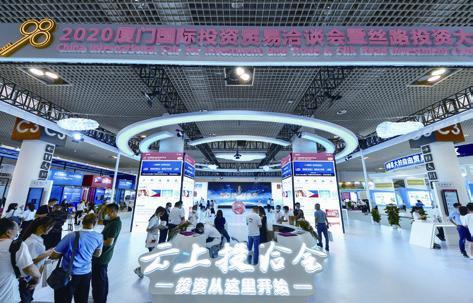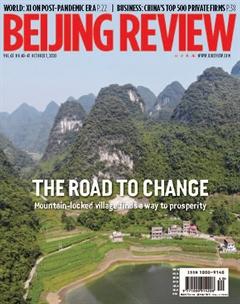New Cooperation Channels
By Wang Xiaosong
The annual China International Fair for Investment and Trade (CIFIT), held in Xiamen, Fujian Province in southeast China, from September 8 to 11, had an online version too for the fi rst time, this being a special period of novel coronavirus disease (COVID-19) epidemic prevention and control measures. Matching its new form, it focused on new themes as well, such as new infrastructure, the digital economy and technological innovation, exhibiting products with new technologies.
Besides CIFIT, other expos held recently in China have also adopted new technologies and new forms to promote economic activities while ensuring COVID-19 prevention measures. The spring China Import and Export Fair (Canton Fair), once postponed, was held online in June, a first in its history. Advertising campaigns, matchmakings between buyers and sellers, negotiations and all other activities made it possible for participants in any part of the world to conduct business without leaving home. The autumn edition of the fair will also be held online in October.
The China International Fair for Trade in Services (CIFTIS), held in Beijing in September, had both actual-virtual and offline-online versions. The cloud CIFTIS had three dimensional virtual exhibition booths using 5G, live-streaming and online translation. There were all-media video broadcasts of conferences, breaking geographical and language restrictions.

This years CIFIT, Canton Fair, as well as CIFTIS were held against the backdrop of profound changes in both the domestic and overseas markets, restricted international economic activities and a global recession. The adoption of new forms at major expos has not only become an alternative in this special period, but also reflects the actual need of the market, as well as the backbone role played by innovative technologies.
Boosting two-way investment
Fairs with innovative concepts and new forms demonstrate the Chinese Governments resolution to promote high-level opening up and restore global confidence through two-way investment promotion.
Opening up is a basic national policy of China. Since the reform and opening-up policy was adopted in 1978, China has been constantly improving the domestic environment to attract foreign investment, which, in turn, has advanced its open economy and stimulated its economic growth. The scale of foreign investment has expanded, foreign capital utilization has been enhanced, and the industrial structure of foreign investment optimized. Also, foreign investment in China is now increasingly spent in inland regions.
Chinese enterprises have also made big strides in investing abroad. In 2000, the government put forward the “going global” strategy for Chinese companies. Since 2012, China has further coordinated the domestic market and the international market, encouraging Chinese companies to invest in overseas markets. In 2013, the Belt and Road Initiative was proposed to encourage Chinese capital, technology, products, services and culture to go global, marking the beginning of a new phase in Chinas outbound investment.
Chinas investment in the world has been increasing steadily, which has not only improved Chinese companies international competitiveness, but also prompted industrial transformation and upgrade of Chinas economy, achieving mutual benefi ts and common development with other countries.
However, with an anti-globalization trend prevailing in recent years, protectionism is on the rise around the world, impeding the flow of global commodities and capital. China is facing a number of challenges such as intensified trade and economic frictions, a low-end position on the global value chain and lack of primary energy resources. If China fails to upgrade the pattern of opening up, it might lose the momentum for transformation, upgrading and sustainable development.
Since the beginning of 2020, the COVID-19 pandemic has disrupted global value chains and inflicted heavy losses on the world economy. It has caused a global recession and affected confidence in all walks of life. Under such circumstances, the Chinese Government has launched a raft of measures to promote opening up in an all-round way. Large-scale projects have been signed and implemented, favorable policies to facilitate two-way investment have been released and the negative list for foreign investors has been shortened. Foreign investors have wider access to the Chinese market, while the major expos have created an important platform for international cooperation and communication and high-level opening up.
CIFITs new mission
While the Canton Fair aims to boost commodity trade and CIFTIS focuses on service trade, CIFIT promotes investment, especially two-way investment. The three fairs, each with their own characteristics, complement one another, building a system of trade fairs that further advances the opening-up policy.
Compared with the trade in goods and services, the fl ow of production factors in the international market can better refl ect the depth and breadth of a countrys participation in global economic activities. Investment growth has a particular bearing on high-level opening up. This year, 41 major projects were signed at CIFIT, many of which are from sectors once closed to foreign investment such as power, energy and smart transportation. This means CIFIT has implemented the shortened negative list for foreign investment and expanded the scope for foreign investors.
Taking CIFIT as an opportunity, some local governments launched high-value investment projects, including in strategic emerging industries, modern service and agriculture, infrastructure and equity cooperation. This indicates that governments at all levels in China are taking concrete action to implement the Foreign Investment Law and its supporting regulations, striving to create a stable, fair, transparent, and predictable business environment.
In the future, the government will substantially increase the sectors open to foreign investment and encourage more foreign companies to avail of the beneficiary policies. At present, the authorities are stepping up with policies and measures to stabilize foreign trade and investment as well as facilitate outbound investment.
With the impact of COVID-19, global cross-border investment has witnessed a sharp decrease. But major fairs like CIFIT demonstrate Chinas unswerving determination to adhere to a high-level opening-up policy and globalization. This will promote the cross-border circulation of various production factors as well as steady and orderly development of two-way investment, accelerating global economic recovery. The presentation of major new economy projects at CIFIT indicated the future direction of development. It will shore up global investment confi dence and combat the fallouts of COVID-19 for healthy development.

